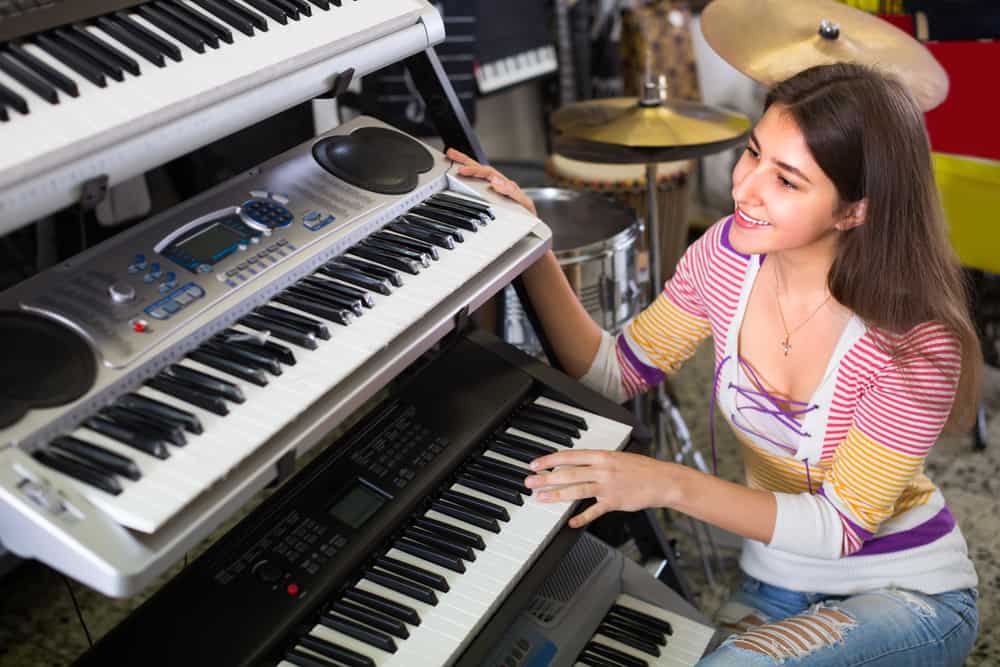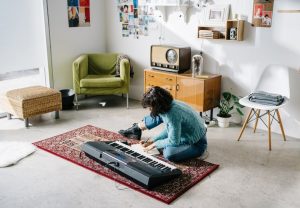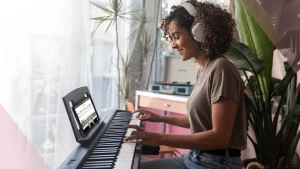If you are just starting out on the keys, buying the right keyboard or piano is a crucial step. You are obviously not going to buy an expensive Steinway as your first piano. However, you might be confused as to which particular piano (or keyboard) you should buy as a beginner student. However, you do not need to worry too much. This article will help you out in selecting a suitable instrument according to your budget and requirements.
If you are looking for a detailed guide on all the different types of pianos and keyboards, continue on to the rest of the article. However, if you are only looking for a quick recommendation for beginner students, any good electronic keyboard will do.

Different Types of Pianos (and Keyboards)
Learning to play the piano can seem difficult at first. If you do not already own a piano, you may have no idea whether you should buy a baby grand or a cheap electronic keyboard. You may not even know the difference between the two. However, we are here to help you understand so that you can make an informed decision.
If you want a keyboard or piano to learn how to play it, you have three main options. You could either go for an acoustic piano, a digital one, or an electronic keyboard.
Acoustic Piano
There is nothing better sounding than a full-fledged acoustic piano. This type of piano uses real wood and actual strings to create the musical notes. The result is a very nice, natural tone of the produced sound.
Acoustic pianos have two main subcategories: Upright, and Grand.
Upright Acoustic Pianos
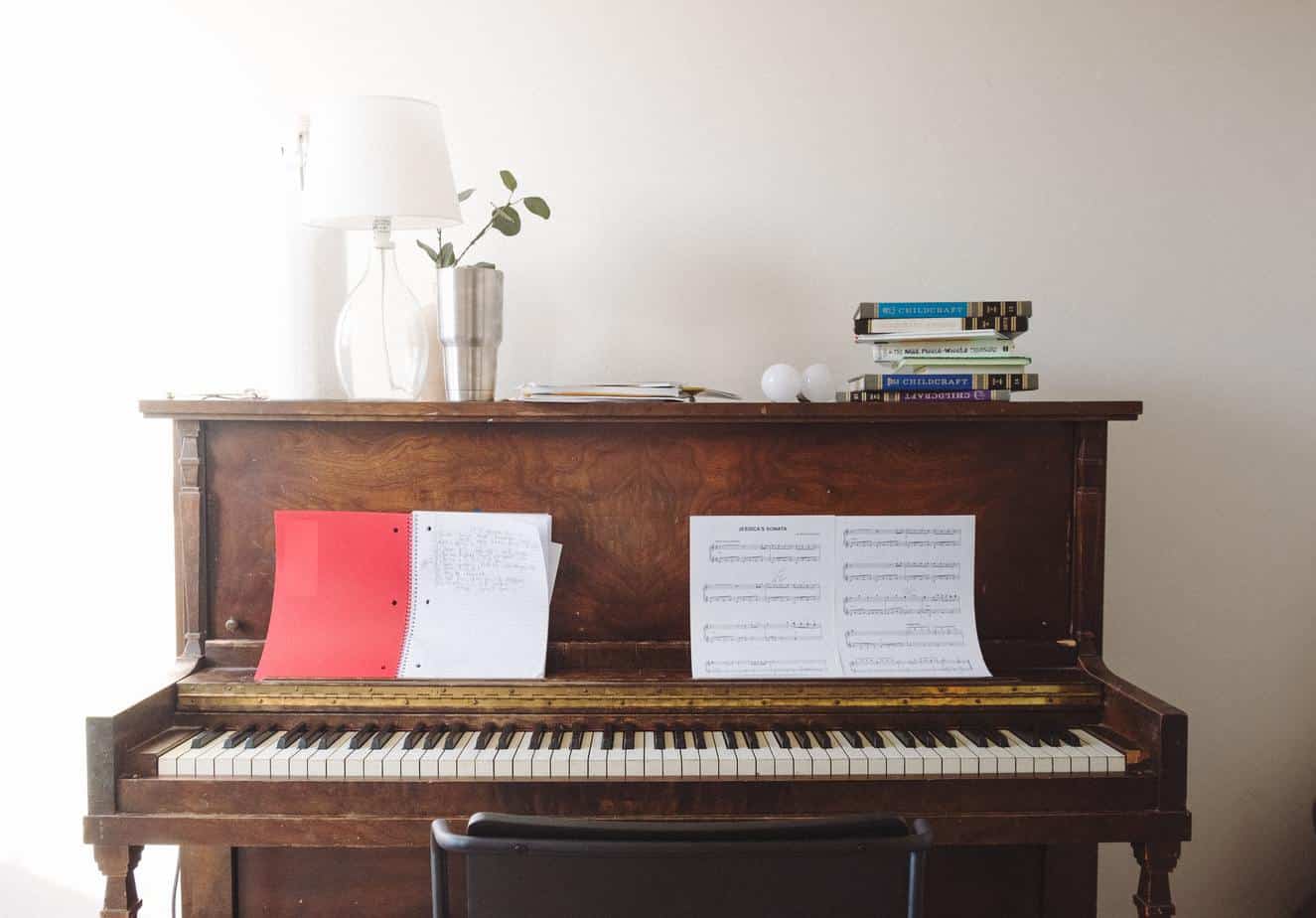
? An upright piano has a vertical soundboard along the height of the piano.
Upright pianos, also known as vertical pianos, are pianos, which have their soundboard and plane of the strings running vertically. As the strings run at a 90-degree angle to the keys, vertical pianos are able to achieve a very compact form factor. People may choose an upright piano over others due to the small amount of floor space it takes.
Grand Acoustic Pianos
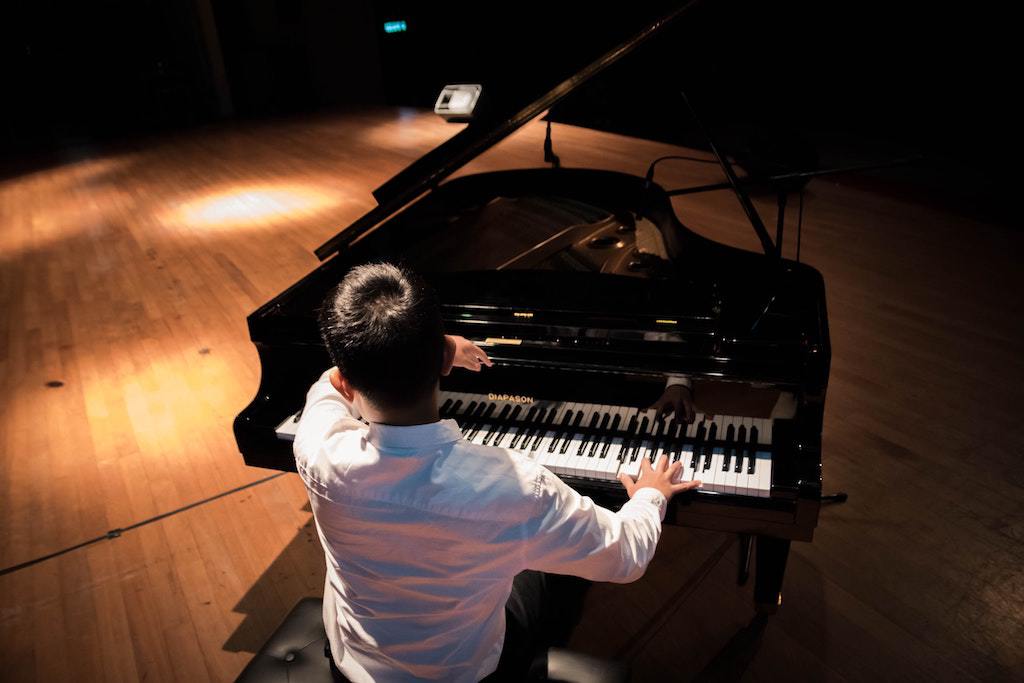
? A grand piano has a big soundboard at the back.
The other main sub-category of acoustic pianos are grand pianos. In this type of piano, the soundboard and plane of the strings run parallel to the keys. The piano has a big soundboard jutting out from the back on which the strings run horizontally to the ground. Though grand pianos take up considerably more space than an upright, many musicians prefer the former.
Grand pianos have much better responsiveness, as well as better quality of sound. Grand pianos are able to achieve a wider dynamic range, expansive tonality, and a rich resonance of the musical notes. These allow the pianist to play quickly repeating notes, or play extremely softly. The pianist can create music that has a more lively emotional expression with a grand piano.
Baby Grand Acoustic Piano
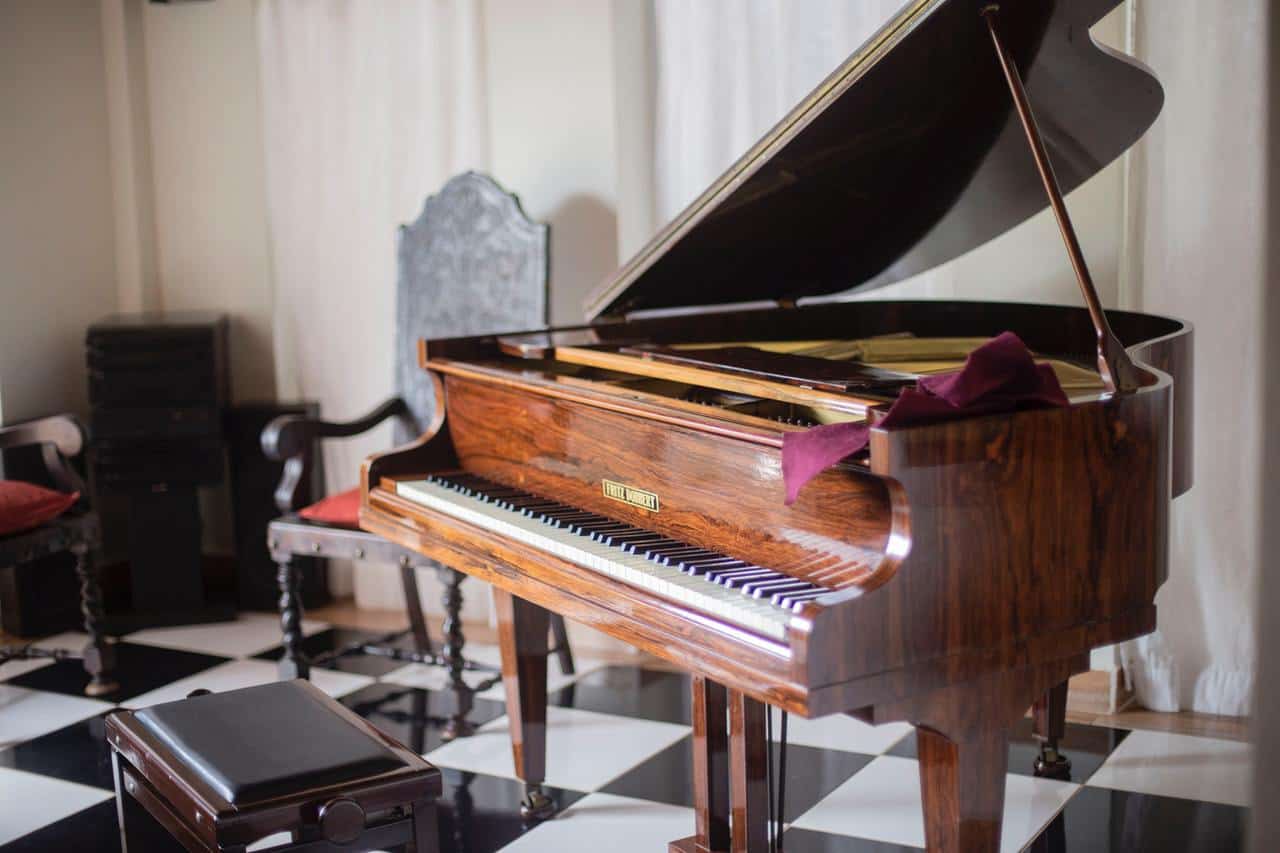
? A baby grand piano has a slightly smaller soundboard than a grand piano.
You cannot, however, find space in any room to fit a gigantic grand piano. A good compromise between a grand piano and an upright one is in the form of a baby grand. Like a grand piano, the baby grand’s strings run parallel to the ground.
However, unlike the grand piano, the length of the strings is much shorter. The reason for this is to save the limited floor space. A baby grand may not sound as good as a full-fledged grand piano, but you can comfortably find space in your living room for it without completely clearing it out. Additionally, a well-made baby grand piano can sound much better than an upright one.
Digital Piano
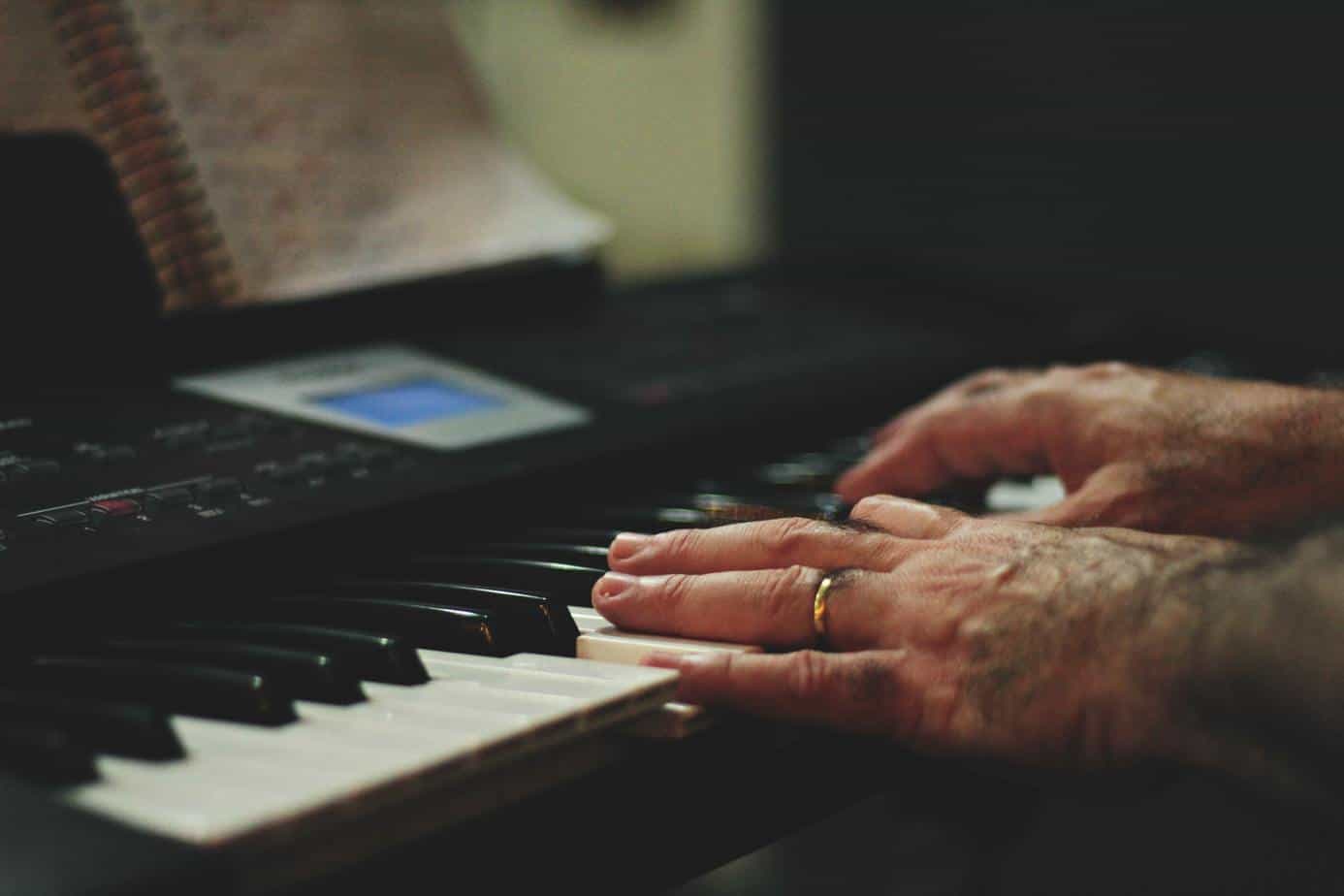
? Digital pianos do not have actual strings for recreating sound.
Digital pianos do not have any real strings to create the musical notes. Instead, they rely on electronics to recreate the music. You might be thinking to yourself, “Isn’t that like an electronic keyboard?” And you would be right – almost.
The digital piano and the electric keyboard both use the same method of generating music. The key difference between them is in the way they look and sound. A digital piano emulates an acoustic piano in both aesthetics and the music they produce.
In a good digital piano, you will find weighted keys that make it feel as if you are playing on the real thing. They also have similar sensitivity to speed and pressure and provide a better range of dynamics to the sound. They also achieve the acoustic piano look through their cabinet style console. With a well-designed digital piano, you can get a taste of what the real deal sounds and feels like – all at a fraction of the actual cost.
While it cannot fully capture the essence of an actual acoustic piano, a digital one can provide you with a good place to start. These provide a much more budget-friendly option to learn the keys for beginners.
Inexpensive Electronic Keyboard
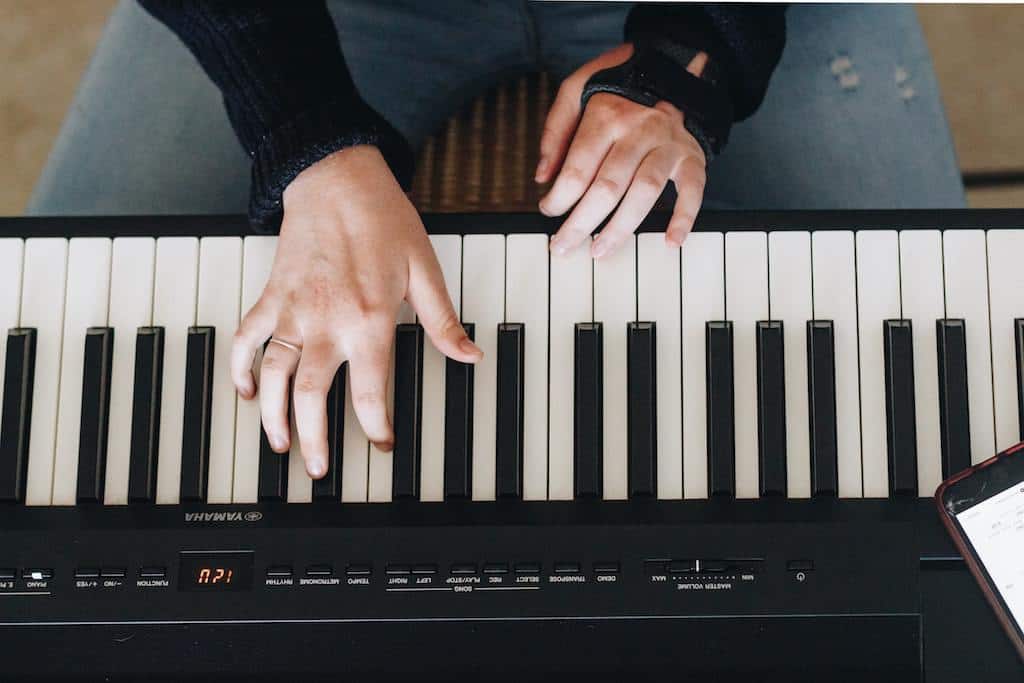
? Electronic keyboards offer an inexpensive way to learn how to play the keys.
Electronic keyboards, on the other hand, offer a much more inexpensive option to get you started on the keys. They come in a variety of different sizes and vary greatly in price. You can buy an expensive professional synthesizer costing thousands of dollars.
Alternatively, you could get a cheap one that only sets you back a few hundred bucks. For a beginner student, the latter option is better-suited, as you can learn how to play the keys on either one. The more expensive option would not provide any more useful features if you are just starting out.
Like a digital piano, an electronic keyboard relies on electronics and complex circuitry to generate the sound. Unlike the digital piano, however, it does not mimic the sound of an actual acoustic piano. Instead, electronic keyboards are more like small synthesizers. Electronic keyboards allow you to digitally recreate sounds of different musical instruments, such as pipe organs and violins, etc. Some of them even come with prerecorded rhythm tracks on-board.
A major difference that matters greatly for beginner students is the number of keys on the keyboard. 49-key keyboards and 61-key keyboards are extremely commonplace. However, if you want the maximum learning experience, you should look for a keyboard that has 88 different keys.
Should You Go Acoustic or Digital? Or Should You Opt For an Electronic Keyboard Instead?
So which of these three instruments is the best for beginner students? The answer depends entirely on your situation and requirements.
➕➖ Pros and Cons of Acoustic Pianos
If you have the budget and space for it, there is nothing that sounds more marvelous than an acoustic piano. However, most of us do not have the floor space or the money to have a huge grand piano in our living room. Realistically, an upright piano is a far more suitable option instead. It sounds great, it can fit inside a well-sized music room, and it does not make a huge dent in your wallet at the same time.
However, all acoustic pianos (be they upright or grand) require regular tuning and maintenance. The sound of the piano adapts to changes in temperature and humidity. If you have a piano in your house, you will need to tune it occasionally to keep it playing smoothly. This can be a complicated task and you might need a professional to come to your house and help you with it.
Keep in mind that acoustic pianos are also heavy and difficult to move around. You need to have a specific permanent place inside your house to keep the piano.
Composers created classic piano arrangements for playing on acoustic pianos (usually grand pianos). Have a listen to how melodic the notes sound in Johann Pachelbel’s Canon. You can even learn how to play this for yourself with Skoove.
If these slight drawbacks do not worry you too much, then an acoustic piano is right for you. Otherwise, you should consider buying a digital piano instead.
➕➖ Pros and Cons of Digital Pianos
Since a digital piano emulates the look and feel of classic acoustic pianos, they are a great option for beginners. They are typically less expensive than acoustic pianos. Thus, you do not have to spend ludicrous amounts of money when you are just picking up a new hobby. At the same time, you can get a feel for how playing a piano is actually like. If you decide that it is a hobby you are interested in the long run, you can invest in an acoustic piano later on.
A digital piano is also a good option for those who do not have the space inside their house for an acoustic one. They do not require as much floor space as an acoustic one, so you can easily place them in a small room. They are also much more lightweight and portable. You can actually stash them away when you are not playing to make more space in your room. You do not require a permanent space inside your house to keep a digital piano.
You can often find a headphone jack on digital pianos. These allow you to practice whenever you want without disturbing anyone else inside the house. This makes digital pianos especially suitable for those who live in an apartment with thin walls.
Digital pianos have one other ace up their sleeves. With built-in MIDI capabilities, they are an excellent choice for producers of electronic music.
Unless you are a piano purist, a well-made digital piano will serve your needs well. If you are just starting out on the keys, a digital piano is an extremely good option.
➕➖ Pros and Cons of Electronic Keyboards
The major advantage of electronic keyboards over other pianos is that they can be extremely inexpensive. Even if you are on an extremely tight budget, you can still learn how to play the keys with an electronic keyboard.
Apart from the price tag, electronic keyboards share many of the same benefits you get with a digital keyboard. They are small and lightweight, which allows you to store them away when not needed. You can even use them for piano practice on the go! They also have the option to plug headphones in for a quiet practice session.
The caveat here is that playing an electronic keyboard feels very different from playing a digital or acoustic piano. Electronic keyboards usually do not have weighted keys, so they do not properly prepare you for playing an actual piano.
The weighted keys on a well-made digital piano respond much like the keys on an actual acoustic piano. These build up your hand strength and prepare you to play an acoustic piano in the future. With most electronic keyboards, however, you will not get the same finger exercise.
The other major disadvantage is that a 49-key or even 61-key keyboard may not allow you to play every piano piece you want. You often require the full 88 keys to play some piano compositions.
Since digital pianos and electronic keyboards use digital methods to recreate sound, they are able to create various different tones of sounds. That is why you hear them in many pop songs today. Listen to how different the instrument sounds in Angels by The XX. Such reverberating notes are simply not possible to create with an acoustic piano.
Conclusion
Everyone’s situation is different and only you can tell which of these three instruments will best suit your needs. However, everyone has room in their budget for an electronic MIDI keyboard. You also get the option of plugging the keyboard into your tablet and using an online app like Skoove to learn how to play much more quickly.
The pros and cons of digital and acoustic pianos:
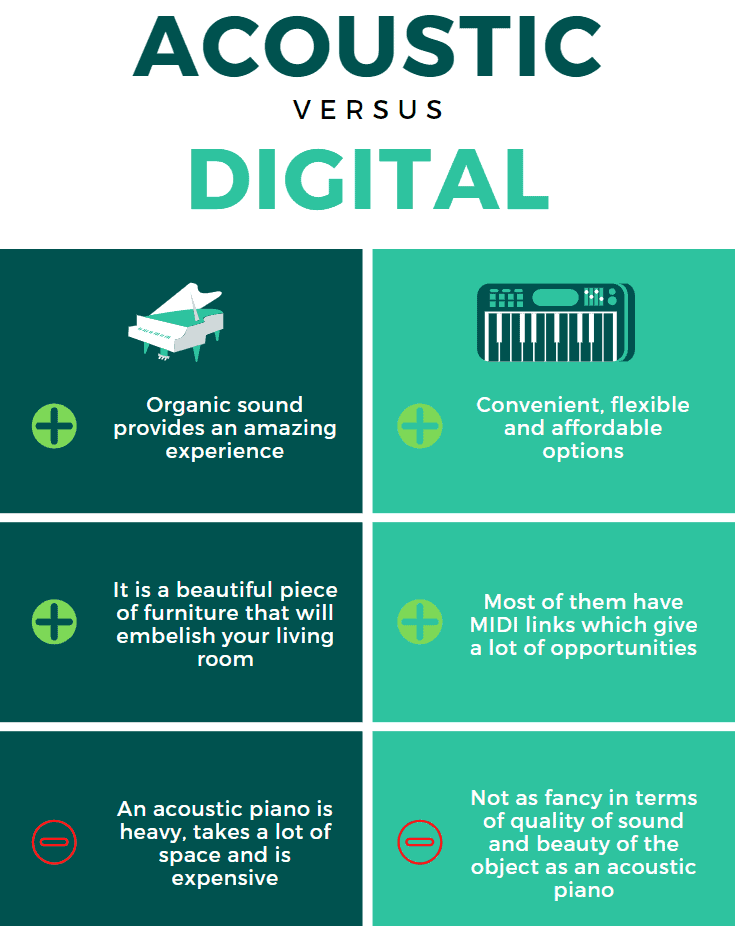
The Next Step: Finding a Piano Teacher
Whether you decided to buy an acoustic or digital piano, or even an electronic keyboard, we have good news for you! Skoove is a piano learning app that is compatible with all of them, so you can use it to practice your finger magic whenever you want.
Finding time in your busy schedule for a human tutor to teach you the keys is a difficult task. This is one of the most legitimate concerns that prevent aspiring pianists from achieving their dreams. If you have always wanted to learn the piano, but could not find the time, Skoove is here to save the day.
How Skoove Can Help You Out
Skoove offers personalized lessons for beginners to teach you how to play the piano at your convenience. Whenever you find some spare time, you can put it to good use by opening the app and completing a lesson.
As you play the keys, Skoove listens to the music you are making using your device’s microphone. If you have a digital piano or keyboard, you can even plug it in to your iOS or Android device to practice silently. Skoove analyzes your performance and gives you real-time feedback to help improve your playing skills. It tells you which parts sound good and which parts you need to work on. Whether it is your timing or your positioning that needs improvement, Skoove will tell you by analyzing your performance in real time – just like a human tutor!
Visit the FAQ page to check which piano they recommend from their partners. Also, check out
Lessons for Beginners
If you are just starting out on the keys, we recommend the starter lesson comprising the first part of Bill Wither’s “Lean on Me”. The lesson will teach you about the basics of piano playing and will also familiarize you with the app’s different functionalities. Try it out for yourself by clicking the link below.
After the first lesson, you should continue the rest of the Piano Beginner 1 course. This will take you through proper finger positioning and teach you about different notes and chords in a progressive manner. The next lesson will teach you how to play with five different fingers:
Progress in Skill Level with Skoove
As you advance in skill level, you can move on to the intermediate, and then the advanced courses. For a glimpse of all that the app is able to teach you, take a look at this lesson outlining White Keys by. With enough practice with Skoove, you will be able to play the whole composition with both of your hands.
Try Out The App for Free!
Skoove allows you to learn the piano using your desktop or your mobile phone. For desktops, you can access the service for free in your favorite web browser right now. You can download the iOS or Android app and practice with your phone or tablet. The free version of the app teaches you basic lessons. However, you can unlock all the available content with a premium trial for a whole week. After that, if you decide to stick with the service, you can choose to pay for the premium subscription.
With a free trial, there is no reason not to check out the app. Go download it now and play the keys to your heart’s content!
Try out your free trial of Skoove today!
Author of this blog post:
Sa Bal worked as a freelancer for digital and content marketing agencies for 6 years. She’s now a professional copywriter, writing extensively on topics related to piano.







